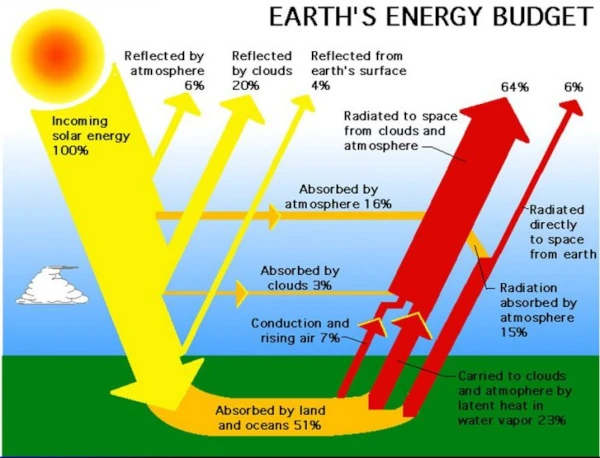
Image description: Earth's energy balance according to NASA
Carbon dioxide (CO₂) molecules are very efficient at absorbing and re-emitting the Earth's heat in the form of infrared radiation. Carbon dioxide (CO₂) is more concentrated in the lower layer of the atmosphere, called the troposphere (8 to 15 km altitude, depending on latitude and weather conditions).
The question of why carbon dioxide (CO₂), although heavier than oxygen (O₂), does not remain stuck to the Earth's surface is related to several factors.
Gases behave differently from solids or liquids; they mix easily through diffusion.
Although carbon dioxide is denser than air (which is mainly composed of nitrogen and oxygen), it is not stationary. CO₂ molecules continuously mix with those of other air gases, contributing to its homogeneous dispersion.
In the troposphere, turbulent air movements constantly mix the different layers of the atmosphere, preventing the formation of stable gas layers. Moreover, gas molecules move quickly and randomly. This motion, known as Brownian motion, means that even heavier gases like CO₂ are constantly in motion, preventing their sedimentation on the ground.
CO₂ tends to diffuse into the surrounding air, helping to disperse CO₂ molecules in the atmosphere. This phenomenon is accentuated by air movements, such as winds and convective currents.
The temperature of the atmosphere influences the density of gases. At higher temperatures, gas molecules have more kinetic energy and move faster. This promotes the dispersion of gases, including CO₂.
At normal atmospheric pressure, gases like CO₂ mix effectively with other gases.
Although carbon dioxide is heavier, it constitutes only a small fraction of the atmosphere (about 0.04% by volume). This means that it is diluted in a large quantity of air, contributing to its distribution rather than its accumulation on the ground.
Carbon dioxide does not remain stuck to the ground despite its higher density than oxygen due to the properties of gases, Brownian motion, diffusion, as well as temperature and atmospheric pressure. These factors allow for a homogeneous distribution of CO₂ in the atmosphere, preventing its accumulation on the ground.